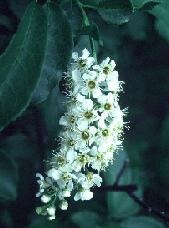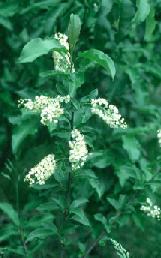
Cal Flora

Cal Flora
Western
Chokecherry
Prunus virginiana L. var demissa Nutt.
A large shrub or small tree up to 25 feet tall. When in
bloom it is covered with long, racemes of many small white flowers that later
give rise to dark round fruits or cherries, each containing a single large hared
stone. It begins flowering in May and June. Fruit in diameter about 3/8
inch long, with fine teeth around the edges. It is located in moist soil along
creeks, on canyon bottoms, sheltered slopes, and along streams and roads,
sometimes forming thickets, at 1400 to 2800 mountain elevation. Nuttall reported
it on the plains of the Oregon.
Food Use: Fruit may be eaten raw or cooked. Very harsh, it is normally
used in pies, jellies etc.. Dark and juicy, it is sometimes edible raw when
fully mature. The fruit can be dried and is then quite nice raw. The fruit is up
to 8mm in diameter and contains a single large seed. Seed may be eaten raw or
cooked. Very nutritious, they are added to pemmican.
The bark and twigs are a tea substitute.
Do not eat the seed if it is too bitter as it may be toxic.. The seed can contain high concentrations of hydrogen cyanide, a poison that gives almonds their characteristic flavor. This toxin is readily detected by its bitter taste. Usually present in too small a quantity to do any harm, any very bitter seed or fruit should not be eaten. In small quantities, hydrogen cyanide has been shown to stimulate respiration and improve digestion, it is also claimed to be of benefit in the treatment of cancer. In excess, however, it can cause respiratory failure and even death.
Medicine: Chokecherry was widely employed medicinally by many native
North American Indian tribes who used it to treat a variety of complaints,
valuing it especially for its astringency and beneficial effect upon the
respiratory system. It is little, if at all, used in modern herbalism. The roots
and the bark are a blood tonic, astringent, pectoral, sedative, tonic and
appetite stimulant An infusion has been used in the treatment of fevers,
coughs and colds. An infusion of the root bark has been used as a wash for
burns, old sores and ulcers.
The inner bark is used externally in the treatment of wounds. A decoction of the
inner bark has been used as a treatment for laryngitis and stomach aches. The
bark is sometimes used as a flavoring agent in cough syrups. The dried and
powdered fruits are used to stimulate the appetite, treat diarrhea and bloody
discharges of the bowels. The astringent unripened fruit has been used by
children as a treatment for diarrhea. The fruit juice has been used as a
treatment for sore throats.
Although no specific mention has been seen for this species, all members of the
genus contain amygdalin and prunasin, substances which break down in water to
form hydrocyanic acid (cyanide or prussic acid). In small amounts this
exceedingly poisonous compound stimulates respiration, improves digestion and
gives a sense of well-being.
Planting: A fast-growing but short-lived tree in the wild[229], it has a
tendency to form thickets of considerable extent from root sprouts. Requires a
well-drained moisture retentive soil. Requires a sunny position. Thrives in a
loamy soil, doing well on limestone. Prefers some chalk in the soil but apt to
become chlorotic if too much is present Most members of this genus are
shallow-rooted and will produce suckers if the roots are damaged. Cuttings of
half-ripe wood with a heel, July/August in a frame. Softwood cuttings from
strongly growing plants in spring to early summer in a frame. Layering in
spring. Division of suckers during the dormant season. They can be planted out
direct into their permanent positions.
